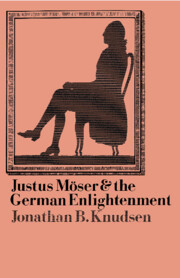Book contents
- Frontmatter
- Contents
- Preface
- Acknowledgments
- Abbreviations
- 1 Justus Möser in the German Enlightenment
- 2 Möser's social universe: urban notability and Enlightenment intelligentsia
- 3 Möser's political universe: secular politics in a confessional state
- 4 Moser's historical universe: regional history and cosmopolitan history
- 5 The party of incremental movement: social and economic reform in Möser's Osnabrück
- 6 Möser's social theory: local patriotism and the defense of the estates
- 7 The dialectic of Enlightenment: the debate over theory and practice
- Bibliography
- Index
4 - Moser's historical universe: regional history and cosmopolitan history
Published online by Cambridge University Press: 17 September 2009
- Frontmatter
- Contents
- Preface
- Acknowledgments
- Abbreviations
- 1 Justus Möser in the German Enlightenment
- 2 Möser's social universe: urban notability and Enlightenment intelligentsia
- 3 Möser's political universe: secular politics in a confessional state
- 4 Moser's historical universe: regional history and cosmopolitan history
- 5 The party of incremental movement: social and economic reform in Möser's Osnabrück
- 6 Möser's social theory: local patriotism and the defense of the estates
- 7 The dialectic of Enlightenment: the debate over theory and practice
- Bibliography
- Index
Summary
Justus Möser's historical vision, like his attitude toward Osnabrück's ecclesiastical institutions, was fully formed only in the crisis of the Seven Years War. But whereas ecclesiastical questions assumed a minor place in his work once the regency of Frederick of York was accepted, the historical problems surrounding the bishopric's institutions preoccupied him for the rest of his life. The result of these reflections was (except for certain minor studies) the multivolume Osnabrück History, on which his fame continues to rest. In it he managed to combine a powerfully expressive German prose with humanist erudition – a remarkable achievement for the period. Furthermore he rejected conventional political narrative for multilayered social and economic explanation at the regional level; this was the intellectual innovation that inspired his contemporaries and historians throughout the nineteenth century and caused historians like Dilthey, Baron, Meinecke, and Moritz Ritter to link him with Winckelmann, Montesquieu, and Gibbon.
Though recognizing Möser's achievement, we must be careful to avoid the Germanic nationalism that has accompanied most studies of Möser's historical writings. Friedrich Meinecke, the most subtle interpreter of Möser's historical work, epitomized the ideological view that emerged at the beginning of the twentieth century by treating Möser in the context of an emerging historicism that stood in dialectical opposition to the Enlightenment. According to Meinecke, Möser was the figure who first broke through the narrow rationalist mentality of Enlightenment historiography. He turned away from moralism in politics, discovered the individual in the social group, and developed the irrational as the significant aesthetic principle in historical explanation. Thus, he was a major contributor to the new “inwardness” that led to historicism.
- Type
- Chapter
- Information
- Justus Möser and the German Enlightenment , pp. 94 - 111Publisher: Cambridge University PressPrint publication year: 1986

